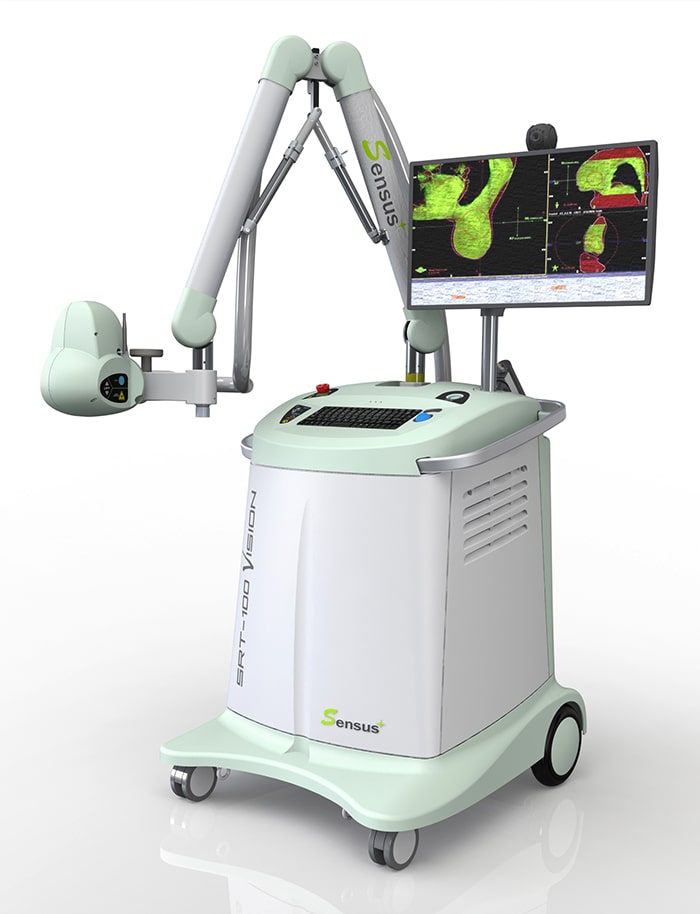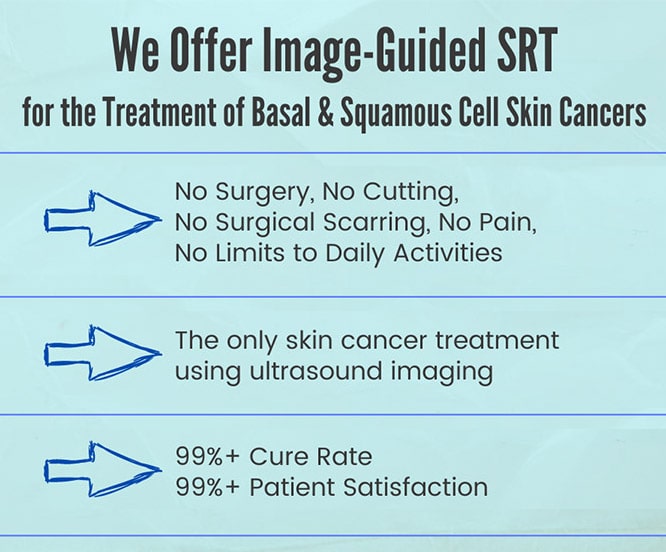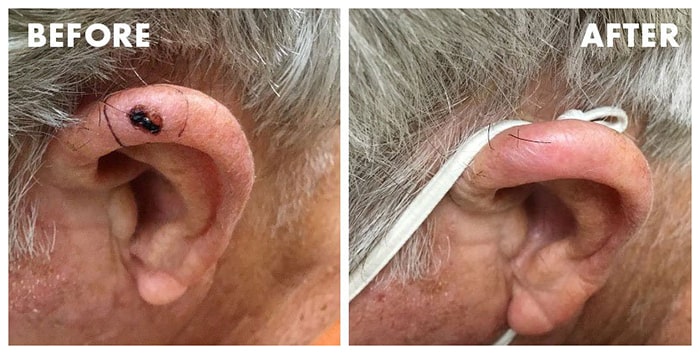What is Image-Guided SRT?
Image-Guided Superficial Radiotherapy, IG-SRT, is a safe, effective, nonsurgical treatment option for non-melanoma skin cancers that uses low levels of X-Ray energy to kill cancer cells and allow normal tissue to grow back in its place. To understand the safety of radiotherapy, understand that the energies utilized are similar to those used in dental x-rays.
Once a skin cancer has been diagnosed with a skin biopsy, and IG-SRT is chosen as the best treatment option, ultrasound imaging is utilized to help determine the best protocol for that particular skin cancer type, evaluated size, and location. An appropriate energy and dosing protocol are then chosen to initiate the therapy. The progress of radiotherapy is constantly monitored by ultrasound imagery.
The dosing protocol is adjusted for each therapy session to continue to target and destroy the skin cancer. A customized lead shield is always prepared to protect the surrounding healthy tissue. The treatment site will experience redness and some swelling, but no pain or long-term scarring. Patients can continue their daily activities in between treatment sessions, including golf, tennis, swimming or anything else.
Benefits of Image-Guided SRT
- 99.6% cure rate for basal cell carcinoma & squamous cell carcinoma
- No surgery
- No pain
- No scarring
- No downtime & quick treatments
- Great cosmetic outcomes
Pre/Post IG SRT
IG-SRT Results
Why Image-Guided SRT?
FDA Cleared
Image-Guided SRT is an FDA cleared non-surgical treatment option for basal cell carcinoma and squamous cell carcinoma.
Insurance Covered
The Image-Guided SRT treatments are covered by most insurances, including Medicare. Our team will ensure that we obtain prior authorization from individual insurance plans before initiating Image-Guided SRT.
Outpatient Procedure
Image-Guided SRT allows you to receive the skin cancer treatment under the care of your trusted dermatologist without having to be referred out for Mohs procedures. Treatment is given in small doses over time. For most people, this means 3 treatments per week for several weeks. Each treatment is painless and takes about 15 minutes.
Targeted Procedure
The superficial radiotherapy is targeted only to the localized area involving the skin cancer and small zone surrounding the cancer. Healthy tissue is completely unaffected. Unlike conventional radiation (based on linear accelerators), Image-Guided SRT does not cause any damage to underlying healthy tissue such as teeth or gums. Protective shields are used when performing treatments near the eyes.
Customized Treatment
During the therapy sessions, patients will be continuously evaluated for improvement utilizing the ultrasound guided imagery. Patients can literally witness the tumors shrinking in front of their eye with each consecutive week. Your dermatologist and certified radiation therapist work in close collaboration to adjust the radiation dosing throughout the treatment duration to ensure complete clearance of your skin cancer.

Non-Surgical Option to Mohs
Image-Guided SRT is good news for the nearly 3.5 million Americans who are diagnosed with non-melanoma skin cancer each year. More than half of these newly diagnosed patients are over 60 and often have a higher risk for surgical complications due to diabetes, heart disease and other medical conditions.
While Mohs surgery has been the traditional choice for basal cell carcinoma treatment and squamous cell carcinoma treatment, it has several drawbacks. The excision of healthy surrounding tissue along with the cancerous tissue can lead to a painful and lengthy healing process as well as a small risk for infection. Patients who undergo Mohs are also often left with scarring and distortion of cosmetically important structures such as ear cartilage and nostrils.
Since nearly 80 percent of skin cancer occurs on visible areas of the face, head and neck, reconstructive surgery is often required. A 2021 report in the Archives of Dermatological Research found that 10% of patients treated with Mohs require reconstruction by a plastic surgeon, usually under general anesthesia.
Non-Surgical Skin Cancer Treatment
Haber Dermatology, Inc now offers a painless, safe and highly effective non-surgical option for skin cancer treatment and keloid removal in Beachwood — Superficial Radiation Therapy using Sensus Healthcare’s SRT-100 Vision.
There are four million new cases of basal cell carcinoma and squamous cell carcinoma diagnosed in the United States each year. Traditional skin cancer treatment options typically involve surgical incisions that extend into healthy tissue and can result in painful healing, a lengthy recovery and unsightly scarring that take an emotional toll on patients. Skin cancer treatment in Beachwood with the Image-Guided SRT Vision is changing all that.
This new non-surgical skin cancer treatment with the Image-Guided SRT delivers a precise, calibrated dose of Superficial Radiation Therapy that only goes skin deep. This low-dose of radiation safely destroys non-melanoma skin cancer cells without damaging healthy surrounding tissue. There is no cutting or stitching, less risk for infection, and no need for reconstructive plastic surgery to repair surgical scars.
Not only this, but the Image-Guided SRT allows Dr. Haber and the Radiotherapist at Haber Dermatology, Inc to see and treat the affected areas. For patients who want the ultimate in advanced superficial radiotherapy, the SRT-100 Vision is built with the same features as the SRT-100, but also offers high-frequency ultrasound for imaging. This allows your physician to view the areas being treated and assess them more thoroughly so treatment can be targeted more precisely. Patients with skin cancer aren’t the only ones who can benefit from skin cancer treatment in Beachwood with Image-Guided SRT. Superficial Radiotherapy is also an effective treatment for keloid removal.
Keloid Treatment
Image-Guided SRT Superficial Radiotherapy is also an effective treatment for keloid removal. When the skin is wounded — whether through surgery or injury — fibrous tissue called scar tissue forms over the wound. In some cases, excessive scar tissue grows, forming a smooth, hard growth over the incision or injury. This growth is called a keloid and is often much larger than the original wound.
Keloids are chronic, non-malignant tumors that often form following surgery, but may also be triggered by other skin traumas, such as acne and chickenpox, ear piercing, burns and other skin injuries. These unsightly, embarrassing and sometimes painful scars affect nearly 18 million people in the U.S.
Image-Guided SRT performed at the Haber Dermatology, Inc office safely destroys the cells that form keloids, keeping the skin smooth as the incision heals. Patients may require a series of treatments, depending on the size of the keloid scar.
BOOK WITH HABERDERM



